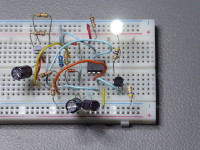Linear analogue LED fader using synthetic inductor

YALALF Yet Another Linear Analogue LED Fader Inspired by the idea of Arnoldus and plots of Clemens Valens.
Oh no, another LED fader ?
Yes, i'm sorry.
The design was inspired by a discussion with Arnoldus and Clemens Valens here on Elektor Labs about : Why not using a tangential oscillator to generate a semi-exponential current through the LED, that makes it's brightness fading appear linear to our logarithmic eyes.
I started experimenting with this idea in my mind and thought : well, lets see what happens when i use an inductor for a change, to get a linearly rising current and try to manipulate this current so it becomes non-linear.
That's where the synthetic inductor came to my mind. I used LTSpice to play with the synthetic inductor and by coincidence discovered that i could generate a semi-exponential curve by manipulating the components that form the synthetic inductor.
The result is not a tangential oscillator, but a relaxation oscillator around capacitor C2+C3, that is charged via the synthetic inductor formed by Q1, R1, R4, C1 and discharged via resistor R5. Charging of C2,C3 via the synthetic inductor gives us a semi-exponential rising voltage over C2,C3 and discharging via R5 gives us an exponential decaying voltage over C2,C3. Comparator U1 (LM311, but could also be made with a 555) compares the capacitor voltage against a voltage created by the divider R6, R9 and the positive feedback resistor R7, R7 creates the necessary hysteresis and thus determines the amplitude at the output. With R6, R9 the DC offset at the output can be moved up or down. R6 and R9 can be replaced by a 10K potmeter to tweak the DC offset when you want the LED to go fully off or not. When the voltage over C2,C3 reaches the threshold voltage, the output of the comparator toggles. When the output is high, the synthetic inductor gets powered and charges C2,C3 through D1 with a semi-exponential current
When the output is low, the inductor is switched off and R5 discharges C2,C3 through D3.
The circuit is dimensioned for a +5V supply.
The disadvantage of the circuit is that you can not change the frequency easily with a potmeter because the charging and discharging times are defined by individual components. The frequency can be changed rudimentary by changing C2+C3, but then C1 of the synthetic inductor and R5 also have to be changed.
Yes, i'm sorry.
The design was inspired by a discussion with Arnoldus and Clemens Valens here on Elektor Labs about : Why not using a tangential oscillator to generate a semi-exponential current through the LED, that makes it's brightness fading appear linear to our logarithmic eyes.
I started experimenting with this idea in my mind and thought : well, lets see what happens when i use an inductor for a change, to get a linearly rising current and try to manipulate this current so it becomes non-linear.
That's where the synthetic inductor came to my mind. I used LTSpice to play with the synthetic inductor and by coincidence discovered that i could generate a semi-exponential curve by manipulating the components that form the synthetic inductor.
- See the LTSpice simulation of the synthetic inductor
- See circuit schematic
- See oscilloscope screen of the semi-exponential LED current
The result is not a tangential oscillator, but a relaxation oscillator around capacitor C2+C3, that is charged via the synthetic inductor formed by Q1, R1, R4, C1 and discharged via resistor R5. Charging of C2,C3 via the synthetic inductor gives us a semi-exponential rising voltage over C2,C3 and discharging via R5 gives us an exponential decaying voltage over C2,C3. Comparator U1 (LM311, but could also be made with a 555) compares the capacitor voltage against a voltage created by the divider R6, R9 and the positive feedback resistor R7, R7 creates the necessary hysteresis and thus determines the amplitude at the output. With R6, R9 the DC offset at the output can be moved up or down. R6 and R9 can be replaced by a 10K potmeter to tweak the DC offset when you want the LED to go fully off or not. When the voltage over C2,C3 reaches the threshold voltage, the output of the comparator toggles. When the output is high, the synthetic inductor gets powered and charges C2,C3 through D1 with a semi-exponential current
When the output is low, the inductor is switched off and R5 discharges C2,C3 through D3.
The circuit is dimensioned for a +5V supply.
The disadvantage of the circuit is that you can not change the frequency easily with a potmeter because the charging and discharging times are defined by individual components. The frequency can be changed rudimentary by changing C2+C3, but then C1 of the synthetic inductor and R5 also have to be changed.



Discussie (2 opmerking(en))